One can use 2 - port parameters as well. We will use the Barkhausen Criterion with current gains. It would seem natural to do this since the circuit is in common collector configuration. It is assumed that sinusoidal oscillation takes place. The Barkhausen Criterion in terms of current gain is:
$$A_i \beta_i = 1$$
The subscripts for the rest of this discussion;
$$ c \ \ and \ \ \beta $$
refer to the amplifier and feedback network parameters respectively.
We describe \$ \ \ A_i \ \ \$ and \$ \ \ \beta_i \ \ \$.
R. F. Shea writes that:
$$ \frac{I_2}{I_1} = \frac{y_{21}}{y_{11} + \Delta^y Z_l} $$
This is the current gain with \$ Z_l \$ as the output impedance. This was found and adapted from "Transistor Applications" by R.F. Shea (page 16). Thus:
$$A_i = \frac {y_{fc}}{y_{ic} + \Delta_c^y z_{in \ \ \beta}}$$
$$\beta_i = \frac{y_{21\beta}}{y_{11\beta} + \Delta^y_{\beta}z_{in \ \ c}}$$
\$ \ \ A_i \ \ \$ is the active device current gain. The current gain of a common collector configuration is negative. Assume
\$ \ \ \Delta^y_c z_{in \ \ \beta} \ \ \$ is small where :
$$ z_{in \ \ \beta} \approx r_{\epsilon} $$
Then:
$$ \ \ A_i = \frac{y_{fc}}{y_{ic}} = h_{fc}. $$
where \$ \ \ y_{fc} \ \ \$ is the forward common-collector trans-admittance parameter and \$ \ \ y_{ic} \ \ \$ is the input admittance common-collector parameter. \$ \ \ h_{fc} \$ is a negative quantity. It is the common-collector "ac beta" of the transistor.
Malvino writes that:
$$ h_{fc} = -(1 + h_{fe}) $$
This is equation (9-28) in "Electronic Principles" Paul Malvino third edition page 244.
Now
$$ \ \ \beta_i = \frac{y_{21\beta}}{y_{11\beta}} = -\frac{C_1}{C_1 + C_2 } \ \ (when \ \ \Delta^y_{\beta}=0) \ \ $$ This is the current gain of the feedback network or " the feedback fraction " of the oscillator . \$ \ \ y_{21\beta} \ \ \$ is the feedback network trans-admittance parameter and \$ \ \ y_{11\beta} \ \ \$ the feedback network input admittance parameter.
We note:
$$z_{in \ \ c} \approx h_{ic} $$
and is the output impedance of the amplifier. R.F. Shea writes:
$$ Z_i = \frac{1+ y_{22} Z_l}{y_{11} + \Delta^y Z_l}$$
where \$ Z_i \$ is the input impedance and \$ Z_l \$ is the output impedance.
This was also found and adapted from "Transistor Applications" by R.F. Shea page 16.
$$z_{in \ \ \beta} = \frac{1 + y_{22 \beta} h_{ic}} {y_{11\beta} + \Delta_{\beta}^{y} h_{ic}}$$
This is the input impedance of the feedback network with an output impedance of \$ h_{ic} \$. \$ h_{ic} \$ is in turn the input impedance to the common collector (emitter-follower) transistor amplifier.
The deltas \$ \ \ \Delta \ \ \$ are the determinants of the y matrices.
We now give a description of the feedback network.
$$ C_1 \ \ and \ \ C_2 $$
make up the usual split capacitor arrangement in a Colpitts Oscillator.
\$ \ \ C_2 \ \ \$ is connected to ground and \$ \ \ C_1 \ \$ is connected to the base of the BJT.
The output impedance is taken from base to ground and terminated with \$ h_{ic} \$.
The junction of the two capacitors \$ C_1 \ \ and \ \ C_2 \$ goes to the emitter of the BJT and is the input to the feedback network. This is where the circuit between the junction of the split capacitors \$ C_1 \ \ and \ \ C_2 \$ and the emitter is broken.
The inductance L is in parallel with \$ C_1 \ \ and \ \ C_2 \$. From this description the feedback network y parameters are expressed as:
$$ y_{11\beta} = j\omega(C_1 + C_2)$$
$$ y_{22\beta} = j\omega C_1 - j\frac{1}{\omega L}$$
$$ y_{21\beta} = -j\omega C_1 $$
$$ y_{12\beta} = -j\omega C_1 $$
$$ \Delta^y_{\beta} = -\omega^2 C_1 C_2 + \frac{C_1 + C_2}{L}$$
Let \$\Delta_{c}^{y} z_{out\beta} \approx 0 \$
From the Barkhausen Criterion: \$ \ \ \ \ \ \ \ \ A_i \beta_i = 1 \$ \$ \ \ \$
$$ \frac{h_{fc} \ y_{21\beta}}{y_{11\beta} + \Delta_{\beta}^{y} h_{ic}} = 1 $$ This is found by multiplying \$ A_i \ \ and \ \ \beta_i \$ and equating with 1 which implies Equation 1:
$$ h_{fc} y_{21\beta} = y_{11\beta} + \Delta_{\beta}^{y} h_{ic}$$
We divide both sides by \$ \ \ y_{21\beta} \$.
$$ h_{fc} = \frac{y_{11\beta}}{y_{21\beta}} + \frac{\Delta_{\beta}^{y} h_{ic}}{y_{21\beta}}$$
The real and imaginary parts must be separated and equated
and we arrive at the real part corresponding from equation 1:
This is equation 1a (the condition for oscillation):
$$ h_{fc} = \frac{y_{11\beta}}{y_{21\beta}}$$
$$ \omega \neq 0 $$
From the imaginary part of equation 1 we obtain equation 1b
(the frequency of oscillation):
$$ \frac{\Delta_{\beta}^y h_{ic}}{y_{21\beta}} = 0 $$
We now analyze equations 1a and 1b:
From equation 1a:
$$h_{fc} = -\frac{C_1 + C_2}{C_1}$$
$$-h_{fc} = \frac{C_1 + C_2}{C_1}$$
\$ -h_{fc} \$ is a positive quantity.
From equation 1b (or the imaginary part) :
$$ \Delta_{\beta}^y \ = 0 $$
the frequency of oscillation is obtained:
$$frequency = \frac{1}{2\pi \sqrt{L C_{eq}}}$$ where
$$C_{eq} = \frac{C_1 C_2}{C_1 + C_2}$$
Maybe this might help.

